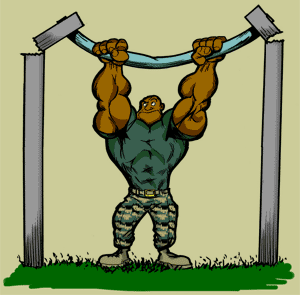
|
|
|

 o-rah and welcome to Semper Fitness. This is the big dawg, Tony Haynes, with another motivating bit of info from Semper Fitness. Being on recruiting duty gives you a new appreciation for the Fleet Marine Force (FMF) or the Fleet as we call it. Well, before I came to recruiting duty, I never realized how out of shape a lot of kids are. Everyone would be surprised to see exactly how many people have trouble passing the initial strength test. "What is the initial strength test?" you might ask. This is the minimum physical standards that applicants must be able to pass in order to ship to recruit training (boot camp). It consists of pull-ups, crunches and a mile and a half run. Future male Marines are required to be able to do 2 pull-ups, 44 crunches in 2 minutes and a mile and a half run in 13:30 or less and future female Marines must be able to do a 12 second flexed-arm hang, 44 crunches in 2 minutes and a mile and a half in 15:00 or less. That may not seem too difficult for some of us. However, this is a big problem for some of today's kids. I guess it's easy to understand this phenomenon in an age when PS2, XBOX and Gamecube are America's pastime. I've decided to help out some of the recruiters and some of those future Marines by showing them how to pass the Initial Strength Test (IST). In this two part article we'll discuss how to increase your number of pull-ups and crunches and how to cut your time down on the mile and a half run. Let's get ready for boot camp.
o-rah and welcome to Semper Fitness. This is the big dawg, Tony Haynes, with another motivating bit of info from Semper Fitness. Being on recruiting duty gives you a new appreciation for the Fleet Marine Force (FMF) or the Fleet as we call it. Well, before I came to recruiting duty, I never realized how out of shape a lot of kids are. Everyone would be surprised to see exactly how many people have trouble passing the initial strength test. "What is the initial strength test?" you might ask. This is the minimum physical standards that applicants must be able to pass in order to ship to recruit training (boot camp). It consists of pull-ups, crunches and a mile and a half run. Future male Marines are required to be able to do 2 pull-ups, 44 crunches in 2 minutes and a mile and a half run in 13:30 or less and future female Marines must be able to do a 12 second flexed-arm hang, 44 crunches in 2 minutes and a mile and a half in 15:00 or less. That may not seem too difficult for some of us. However, this is a big problem for some of today's kids. I guess it's easy to understand this phenomenon in an age when PS2, XBOX and Gamecube are America's pastime. I've decided to help out some of the recruiters and some of those future Marines by showing them how to pass the Initial Strength Test (IST). In this two part article we'll discuss how to increase your number of pull-ups and crunches and how to cut your time down on the mile and a half run. Let's get ready for boot camp.
The first, and I feel the most difficult exercise to build is that all important PULL-UP. Let me take a detour and give you a little Marine Corps history lesson on the pull-up. I know that some of you out there remember when we could do a KIP to help us out with the pull-ups (I'm showing my age again). For those that don't know what a KIP is, it is a way of swinging or jerking your body in a way that makes doing the pull-up a whole heck of a lot easier. If you were one of those poor unfortunate souls that didn't have the rhythm to do a KIP, you started off with the short end of the stick and at the bottom of the food chain (unfairly, I might add). I was fortunate because I could do 20 pull-ups with or without a KIP. The Marine Corps used to be a runner's world. The measure of how physically fit a Marine was depended, almost entirely on how well you ran. Then, one glorious and wonderfully bright Marine Corps day, we were all informed that the Corps was going to the dead hang pull-up. For weightlifters and those that couldn't do a KIP, it was one of the most wonderful days in the Corps. This made the playing field even. Those all important pull-ups are worth five (5) points each on the Physical Fitness Test (PFT). Now, it was time for Marines to start working on strength as well as endurance. Well, this also happens to be one of the biggest problems recruiters face when it comes to the IST. Now that I've let my joy for the dead hang show a little, let's get on with the scoop on how to build them up.
The two major muscles that applicants need to build are back and biceps. Both of these muscles are critical to helping you increase your pull-ups. If you have access to a gym or some sort of workout facility, it will be easier for you to increase your pull-ups. Let's start with the biceps. The biceps are much smaller than the back and will be easier to do first if you work them on the same day that you do back. If you work them on a separate day, that is fine also. You only need to do two to three exercises to build up the biceps for pull-ups. You can start with either standing easy bar curls or seated alternating dumbbell curls. Make sure that you keep you elbows locked into your side and keep them from flaring out. Also, refrain from arching your body or swinging the weight to get it up. It's best to have a spotter to tell you to straighten up when you cheat. If you don't have a spotter, you must pay attention to your form. You will conduct three sets of curls. One warm-up set of between 10 and 12 repetitions with a fairly light weight just to warm the muscles up. Then do two heavy sets to total failure. Total failure means that you can't do another repetition on your own, but you try.
The next exercise that you want to do is 21s. This exercise targets upper, lower and mid biceps. It's called 21s because by the time you finish each set, you will have conducted 21 repetitions. This exercise is done by standing up and locking your elbows into your sides. You can use an easy curl bar or a straight bar. You will lift the weight halfway up for 7 repetitions. On the 7th rep you will bring the weight all the way up to your face. Then you will do 7 more reps halfway down, stopping when your forearms are parallel to the deck. On the 7th rep, you will go all the way down and do 7 more full repetitions, going all the way up and all the way down. Your first set should be a warm-up and the last two sets should be to total failure. Of course this means that on the last set of 7, you might not make it. But that's okay.
Next, we'll focus on the back for pull-ups. I am going to break this up into two different back workouts; one for those who can't do a single pull-up and another workout plan for those who can do two or more pull-ups. Let's start with someone who can't do one pull-up. Believe me, it's not as uncommon as you may think.
If you can't do one single pull-up, you may not be able to do weighted pull-ups and you need to add push-ups to the workout plan (Just to build overall strength in your arms and chest). In that case, you need to start with regular pull-ups using a spotter. Do three sets of assisted pull-ups (3-5 repetitions). Then you will do three (3) sets of lat pull-downs. One warm-up set of 8-12 repetitions and then two heavy sets to total failure between 6-8 repetitions. The grip that you use will depend on how you do your pull-ups. That is, whether you use an underhand or overhand grip on the pull-up bar. Now, I said you would have to add push-ups to your workout if you can't do a single pull-up. Sometime during the day that you workout, it can be directly after your back workout or when you get home later that night, it doesn't matter. You will do a total of 200 push-ups. At first, try finishing this in an hour. As your workouts progress, try finishing the push-ups in less time. Now, if you can do pull-ups, you need to add weighted pull-ups to your workout and subtract the push-ups.

For those who can do two or more pull-ups, you will start with weighted pull-ups. You need a dip belt to do this. Most gyms carry one or you can buy one from some of the sport equipment stores. If you can't find one at either of those places, check online. When you start your workout, do the first set of pull-ups with no weight to warm-up. The first should not be to failure. Next, add between 10-45 lbs, depending on how many pull-ups you can do with no weight, and do two sets to total failure, using a spotter. After that, do one more set with no weight to total failure. Next, you will move on to Lat-pull-downs. Do one warm-up set of 8-12 repetitions and two heavy sets to total failure of between 6-8 repetitions. Conducting this workout plus the bicep workout should help you build up those pull-ups in no time.
That's the scoop this week from Semper Fitness. Next issue, we'll work on those crunches and the mile and a half run. We'll have you ready for boot camp in no time. Until then, stay pumped, stay motivated and oo-rah!
Semper Fi!
Disclaimer:
Neither the United States Marine Corps nor any other component of the
Department of Defense has approved, endorsed, or authorized this Web site.
| OO-Rah.com is now an editorial site to share military stories. If you are looking for informaiton regarding custom t-shirts, please click here. |

